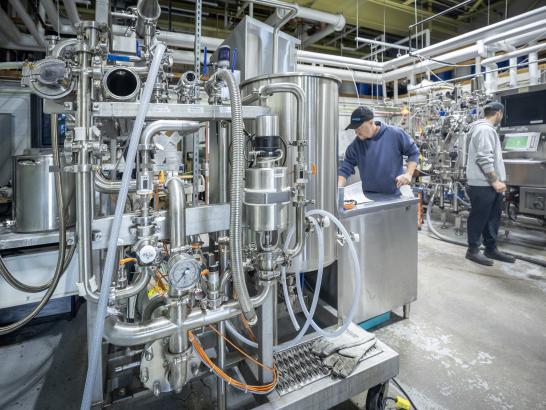The best of both worlds: make Earth a better place for everyone, while ensuring business success. Nova Scotia is a national leader in fighting climate change—and our clean technology industry is reaping the rewards.
Nova Scotia has the most ambitious targets in Canada for reducing greenhouse gas emissions. No wonder the province’s clean technology industry is thriving, driven by a commitment to sustainability, innovation, and global leadership. The province is home to cutting-edge research institutions advancing renewable energy, waste management, and tidal energy solutions. Our access to renewable energy sources and feedstock materials, paired with a skilled workforce and research infrastructure, creates rich and lasting opportunities for research, product development, and commercial-scale projects.
Where profit and sustainability meet
Nova Scotia is an ideal location for companies in the clean technology space thanks to its diverse ecosystem, commitment to sustainability, history of industry collaboration and investment, leading research and development, and a large pool of highly skilled talent. Plus, our geography and coastline provide unique opportunities for wind, tidal, and wave energy development. Are you prepared to take advantage?
Our primary clean technology pathways
Nova Scotia's clean technology industry attracts considerable international attention thanks to our clean technology companies that are making advances in a number of exciting areas—particularly the following.
Energy storage
Nova Scotia is a leader in energy storage innovation, with research focused on advanced battery technologies and grid integration. Our long history in batteries includes companies like Surrette Battery—Canada’s only remaining independent battery manufacturer and leading lead-acid battery producer and NOVONIX BTS, who are conducting ground-breaking research in lithium-ion battery materials and testing.
Bioeconomy
Nova Scotia’s bioeconomy is constantly innovating to find novel and sustainable uses for by-products. From traditional lumber, paper, and shellfish waste, to innovative bioproducts like plastics, fuels, chemicals, and new sources of human and animal nutrition, there are opportunities for co-location and partnerships to produce value-added bioproducts.
Offshore wind (OSW)
Nova Scotia is home to one of the world’s most competitive untapped offshore wind resources, with ample capacity to serve both local and export markets. Nova Scotia alone has the potential to generate more than 60 gigawatts of offshore wind – roughly one quarter of Canada’s current energy use.
Carbon capture, storage, and utilization
New methods to capture, store, and use carbon are being developed and scaled from CarbonCure Technologies’ award-winning concrete solutions.
Green hydrogen
Nova Scotia is actively pursuing the development of a green hydrogen sector. The province’s Green Hydrogen Action Plan lays out seven goals and 23 actions that consolidate and build upon provincial efforts to lay the groundwork for sector development.
Nova Scotia is advancing offshore wind and clean hydrogen production with several proposed projects under development and expertise growing across the entire hydrogen value chain.
Tidal energy
Nova Scotia is a global leader in tidal energy, with the Bay of Fundy’s powerful tides offering significant renewable energy potential. The province is home to FORCE (Fundy Ocean Research Center for Energy), Canada’s leading tidal energy research facility.
FIGURES AND FACTS
Fast Facts
- Tesla’s only satellite battery research facility is in Nova Scotia and is partnered with Dr. Jeff Dahn at Dalhousie University
- Dalhousie University ranks in the top 10 in Canada for sustainability research.
- The provincial government aims to generate 80% renewable electricity by 2030, accelerating opportunities for clean energy investments.
- Nova Scotia has procured 372MW of new wind power which means that 70% of our electricity will come from renewable sources by 2026.
- The BDO Zone Initiative has issued a BDO Zone 'A' rating for Southwest Nova Scotia for 550,000 green metric tons per year of sawmill residuals and by-product wood fibre from the forest sector.
Leading clean tech research organizations
These are just a few of the organizations that play pivotal roles in advancing Nova Scotia’s leadership in clean technology innovation and sustainability.
A leading research facility for tidal energy, located near the Bay of Fundy. FORCE collaborates with developers, researchers, and governments to test and advance in-stream tidal turbine technologies.
Based at Cape Breton University, this centre drives innovation in clean technology, focusing on renewable energy, waste management, and bio-based industrial solutions.
Dalhousie hosts research in battery technology, energy storage, and sustainable energy systems, led by globally recognized experts in clean tech and sustainability.
Located in Dartmouth, this NRC facility focuses on renewable ocean energy, climate adaptation technologies, and innovative clean energy systems for marine environments.
A network supporting clean energy and bioeconomy research, the Hub connects businesses with applied research opportunities in areas like biofuels and carbon reduction.
Nova Scotia Community College conducts applied research in energy efficiency, solar power, and clean energy technologies, helping to commercialize solutions for regional industries.







